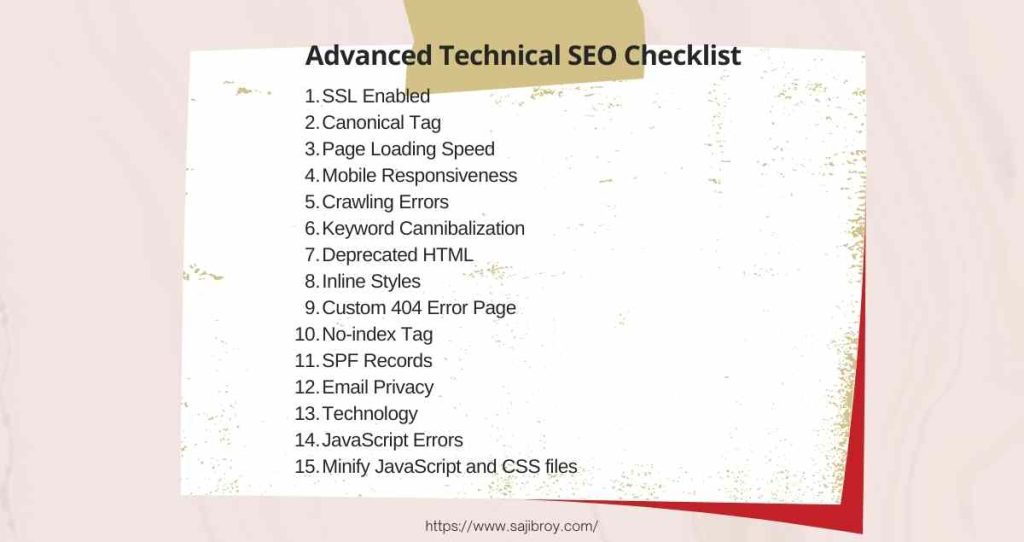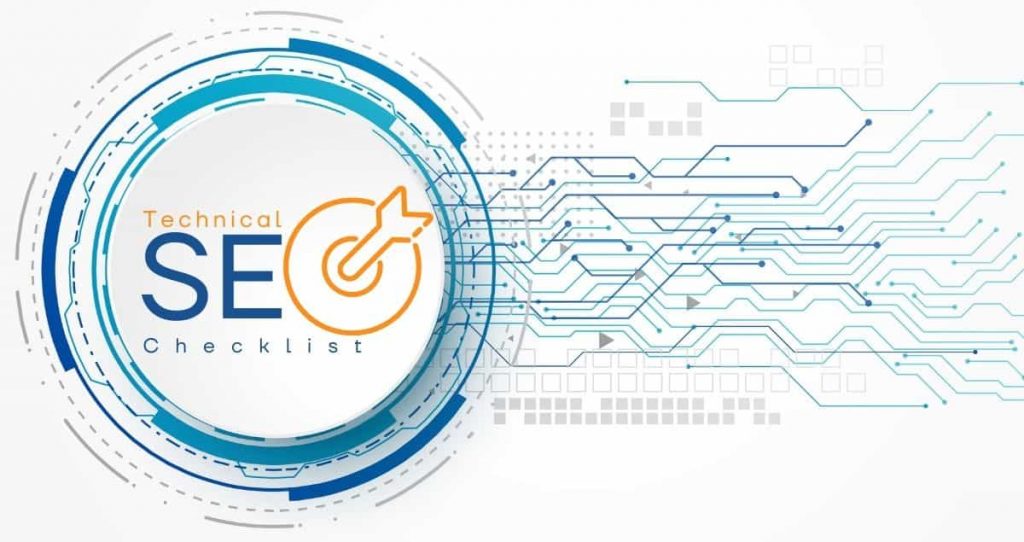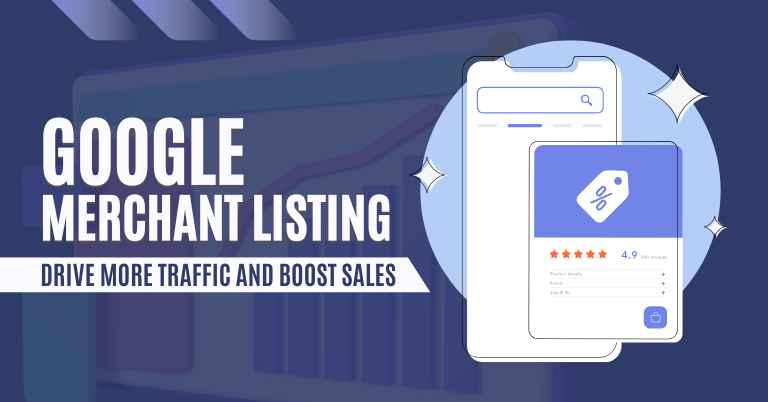It is very important to have a strong SEO strategy in place if you want your website to rank high on the major search engines. There are multiple SEO Ranking factors and each factor also has multiple SEO checklists; like on-page SEO checklist, off-page SEO checklist, technical SEO checklist, etc. Here, I’m going to discuss the technical SEO checklists.
| At a Glance |
|---|
| 1. If the loading time of your site is more than three seconds, 40% will leave and never return. (Google) 2. A survey of internet users found that 47% of polled consumers expect a website to load within two seconds. (Quicksprout) 3. Web Page loading speed and URL indexation are the top technical SEO concerns for SERPs ranking. (Medium) |
Let's See the Topic Overview
Technical SEO
SEO is a lot more complicated than just the content on your website. There are many different factors that contribute to how well your site ranks in search engines. This post will cover technical SEO checklists and some of the most important aspects for you to keep in mind as you work on improving your rankings.
Technical SEO is a set of best practices for improving the performance of your website in search engines. It refers to any changes made on your site that improve how search engines crawl and index content and is part of an overall Digital Marketing strategy for generating more traffic from organic searches.
This includes everything from content to coding, but most importantly it’s about optimizing your site so that it can rank higher and be found more easily by searchers.
Technical SEO doesn’t just involve what you do on the front end, but also how you code behind the scenes. There are plenty of things to cover in this topic when it comes to both technical SEO best practices as well as tools that are available for accomplishing these goals. It encompasses everything from coding languages, page load times, security, mobile responsiveness………..the list goes on!
Importance Of The Technical SEO
For most people, technical SEO is a mystery. But if you’re in the business of providing digital marketing services to clients, then it’s important that you know all there is to know about this topic.
In order to have an efficient marketing campaign, one must create a site that has good design elements and user-friendly features in addition to strong content creation. However, there is another aspect of a website that can make or break its success: Technical SEO.
The importance segments of technical SEO are often overlooked by many businesses. The SEO industry is a vast and ever-changing landscape. As the world moves more towards digital, search engines are continuously changing their algorithm to keep up with these changes. This can make it challenging for small business owners who don’t have significant budgets to hire an outside team or consultant to handle all of these updates. That’s where Technical SEO fixation comes in!
There are many reasons why you may need technical SEO fixes for your website.
- One common reason is that the site has been hacked and needs to be fixed immediately.
- Another reason could be a change in Google’s algorithm or webmaster guidelines, which can affect rankings.
It is important to have an expert handle any changes so they are done correctly and do not make it more difficult to rank well on search engines.
Technical SEO checklists can be daunting but it doesn’t have to be! Here are 5 quick steps that you can take today to start mastering this aspect of marketing:
- Check Google PageSpeed Insights and see if there are any recommendations;
- Perform a crawl test (can use Screaming Frog)
- Run an audit ( can use MajesticSEO or Ahrefs)
- Look at how much duplicate content exists on your site;
- Check security signals (like – SSL Enablality) and other canonical issues.
Technical SEO is an often-ignored part of the overall website optimization process. It should not be, as it can provide a lot of benefits to your site and company. Here are the 15 key points that you need to consider when developing your technical SEO checklists for any new or existing website:
#15 Advanced Technical SEO Checklists

1. SSL Enabled
It is important to have an SSL certificate for a website because it will protect your site from hackers and other cyber-attacks. The SSL Certificate encrypts the data that is being transferred between you and your visitors. But not all SSL certificates are created equal so choose wisely! Make sure you get the right one for the job by checking what level of security it offers.
The need for SSL certificates is not new, but it has become more important recently. What are the benefits of an SSL certificate?
- First of all, it protects your customers’ data from being stolen by cybercriminals outside your website.
- Second, it increases your company’s credibility and conversion rates.
- And finally, you can get a free trial SSL certificate that lasts three months with Let’s Encrypt!
So what are you waiting for? Get started with Let’s Encrypt today!
2. Canonical Tag
It is considered an essential element of the technical SEO checklists. The canonical tag (“rel canonical”) is a way of telling search engines that you want only one version to appear in the results, not multiple. Practically speaking it tells Google which URL should come up when someone does their searches on this particular topic!
A Canonical issue is caused when multiple pages exist of the same content and there is no way to specify which one should rank higher than the others in search engine rankings.
It is the preferred URL for a webpage. It’s usually the URL that search engines index, but it can also be used to redirect traffic from one URL to another. When people search for your site, they might see the wrong URL in their results. Search engines like Google may even show this incorrect information as well.
The problem with the website Canonical issue is that it can be very hard to diagnose. It often takes a lot of time and effort for people to figure out the exact cause of the problem.
3. Page Loading Speed
Without this element, the technical SEO checklists could not be imagined. It’s really frustrating when you have to wait for ages just so you can see what the page is about. Not only does it waste your time, but it also makes the website look unprofessional. That’s why website speed has become one of the most important factors in SEO ranking and web design.
Website loading speeds are measured by how many milliseconds it takes for all the content on a webpage to be fully loaded. A slow website means users are waiting longer for pages to load, which decreases customer satisfaction and leads them away from your site.
Google has even started rewarding sites with fast page loads in search engine rankings. But how do you know if your site is loading too slowly?
Google Web Vital is a new feature in the Google search console that helps you understand how your site is performing on mobile devices and desktops. It shows the website page speeds. It also provides tips for improving the user experience on mobile devices.
Loading time can be improved by optimizing images, using a content delivery network, or compressing JavaScript and CSS files.
4. Mobile Responsiveness
A responsive website is a site that adapts to the screen size, allowing for optimal viewing across all devices. Mobile responsiveness, is required as the top element for the technical SEO checklists. The importance of responsive web design for SEO has increased dramatically in recent years as more and more people are accessing the internet on their mobile devices.
Google has recently announced that it is penalizing websites that are not mobile-friendly. This means that the site will be ranked lower on Google searches, and can even lead to a complete de-listing of your website.
The only way you can avoid this penalty is by making sure your website is optimized for all devices, including smartphones and tablets. Now more than ever before, responsive web design (RWD) should be at the forefront of any SEO strategy as consumers turn increasingly to their mobile devices to find information about products and services.
With RWD, you’re able to provide an optimal user experience across multiple platforms without having to create separate versions of your content or rely on sub-optimal workarounds like redirects or responsive images.
5. Crawling Errors
Crawling errors make it difficult for search engines like Google to find and index your content, which can greatly affect how well you rank in organic search results.
These crawl errors could be caused by a number of reasons, including algorithm updates, robots.txt file errors that have been removed from the site or crawlers not being able to retrieve content because it is missing. Although they may seem harmless, these errors can negatively affect SEO if left unresolved.
If your site is not being crawled, your site will not be indexed in search engines; so people will never find your site in search engines.
Crawling Errors are frustrating for website owners and users alike, but there are ways to fix them before SEO is affected!
6. Keyword Cannibalization
Keyword cannibalization is when two or more pages on your site are competing for the same keyword. This can lead to both of them ranking lower, and one page getting penalized by Google. It’s important to stay away from keyword cannibalization because it hurts SEO rankings for all of your web pages in general.
The concept behind keyword cannibalization is that if you have multiple pages targeting the same search query, they will compete with one another for ranking in Google’s SERP (Search Engine Result Page). The result is that neither page ranks high enough to meet its potential due to being outranked by other competitor sites that are not affected by this issue. In addition, there may be a penalty imposed on the impacting webpage for over-optimization.
7. Deprecated HTML
What does it mean when a website is using deprecated HTML? What effect could this have on the site’s SEO and ranking in search engine results pages (SERPs)?
Google is constantly updating its search algorithm to improve the user experience and provide an accurate representation of content. The latest update, called “Mobile-First”, has a significant impact on how Google ranks sites that use deprecated HTML tags. Most notably, they will rank worse for searches that include those tags.
Deprecated HTML tags are those that have lost their relevance with the introduction of new technologies. That’s right, it’s time to say farewell to these old friends: < b >, < i >, and < u >. With the introduction of new design trends like flat design, there is no need for these outdated elements anymore. You deserve better than dated designs! These deprecated tags may not seem important now, but they will affect your SEO rankings by causing pages containing them to rank lower on Google searches.
8. Inline Styles
It is important to know the SEO impact of using inline styles CSS on a website. Inline style sheets are created by inserting style rules directly into the HTML code of a web page, and it’s typically not recommended for large websites or eCommerce sites.
Inline styles are an older coding practice and discouraged in favor of using CSS style sheets, due to their ability to degrade page load performance. There’s also evidence that shows how inline styling can unnecessarily complicate HTML code when used incorrectly – which would result in slower loading times for your website or blog post!
9. Custom 404 Error Page
A custom 404 error page is typically displayed when a web browser has tried to access a webpage that cannot be found. The purpose of this page, which typically contains an error message and links to other pages on the website, is to provide visitors with an opportunity to find what they are looking for. A custom 404 error page can do more than just display an error message by providing content that could solve the problem or answer questions.
It’s frustrating when this happens, but did you know it also has an impact on SEO? Google and other search engines will penalize sites with high numbers of 404 errors because they may believe those pages to be low quality or unreliable. Creating a custom 404 error page is also the best way to improve a website’s user experience.
10. No-index Tag
When doing SEO, it is important to know what type of impact a No index tag can have on your website. A no-index tag tells search engines not to index the page and not to follow the links on that page.
This means Google will still crawl the pages but won’t display them in its results.
In the fast-paced world of SEO, it is important to understand how Google crawls and indexes your site.
One way to do this is by using a no-index tag on the page. In order for Google to crawl and index content on your website, there are certain rules put in place. The one rule that stands out most when discussing No Index tags is that if you have an “index” directive in the robots meta tag or within code on the page telling Google not to index a specific URL or set of URLs, then those URLs will be removed from search engine results pages (SERPs). This essentially means any content at these URLs will not show up in SERPs.
11. SPF Records
Do you know what an SPF record is? It stands for Sender Policy Framework, which is a way to verify the sender of emails. There are many benefits to having one, but it can also have negative side effects on your SEO if not set up correctly.
A recent study has shown that increased use of SPF records can have a major impact on your SEO. This is because when you send out the email, it will show up in the recipient’s inbox as “from” whatever domain you’re sending from and not just “from” Gmail or Yahoo or Hotmail. When this happens, if that domain doesn’t have a good reputation, then all emails coming from that domain will be considered spam and ignored.
The solution? Implement the SPF records for your domains!
12. Email Privacy
Email privacy, also known as “data protection”, is becoming more prevalent with recent news about data breaches, hacks and leaks occurring all over the world. With this increased awareness of email privacy comes an increased emphasis on how it can affect SEO rankings.
Though it’s not directly a SERP ranking signal, the webmaster should make it private for overall privacy purposes.
You are probably reading this blog post because you are interested in the impact of email privacy on your SEO. Well, I am here to tell you that there is a huge difference between having your emails available to everyone and them not being visible at all.
It should be noted that if someone has access to your inbox then they have access to any links within the emails, which means that it can have an impact on how high up in Google searches you show up for certain keywords. There are ways around this though!
One way is by using a disposable email account or forwarding messages from your main account into one with more privacy settings so people don’t see everything else going on in your life while they’re looking through these messages. So, do it privately today.
13. Technology
Which technology you have used for your web property is also considered an SEO ranking factor. It includes Server IP Addresses, DNS Servers, Web servers and many more.
When a webmaster uses weak and unsecured technology his/her site never gets a better position on SERPs. And Google can throw this site into the sandbox. So, always use smart and updated technology for your website.
14. JavaScript Errors
Google has announced that site errors are now a ranking factor for their algorithm. If you have JavaScript errors on your website, it can lead to significant drops in rankings and traffic.
JavaScript errors on a website have an adverse effect on search rankings. This is because the crawler software used to index websites can’t read content with JavaScript errors and thus it doesn’t index pages or rank them appropriately.
15. Minify JavaScript and CSS files
As websites grow in size, the number of JavaScript and CSS files also increases. This can lead to bloated web pages that take a long time to load. Minified versions of these files are not only faster but also have less code that is easier for search engine crawlers to understand and index your website content more efficiently.
There are many minification tools that compress JS code by removing unnecessary whitespace, comments, formatting characters, etc.
Exploring Supplementary Technical SEO Considerations
In the dynamic realm of digital marketing and search engine optimization (SEO), staying ahead of the curve requires a comprehensive understanding of not only the core technical SEO practices but also the supplementary factors that can influence your website’s performance and visibility. Let’s delve deeper into these additional technical SEO considerations:
- Voice Search Optimization: With the proliferation of voice-activated devices and virtual assistants like Siri, Alexa, and Google Assistant, voice search has emerged as a significant trend in SEO. Optimizing your website for voice search SEO involves tailoring your content to match natural language queries and conversational patterns. Long-tail keywords, question-based content, and structured data markup can help your site appear in voice search results.
- Artificial Intelligence (AI) and Machine Learning: Search engines are increasingly leveraging AI and machine learning algorithms to deliver more relevant and personalized search results. Understanding how these algorithms work and incorporating AI-driven tools into your SEO strategy can enhance your website’s performance. AI-powered tools can analyze data, predict user behavior, and optimize content for maximum impact.
- E-A-T (Expertise, Authoritativeness, Trustworthiness): Google’s E-A-T principle has become a crucial ranking factor, emphasizing the importance of establishing expertise, authoritativeness, and trustworthiness in your website content. Demonstrating expertise in your niche, building authoritative backlinks, and maintaining transparency and credibility are essential for enhancing E-A-T signals. This helps search engines and users trust your website’s content and recommendations.
- Structured Data Markup: Implementing structured data markup, such as Schema.org markup, helps search engines better understand the content and context of web pages. By providing structured data, you can enhance the appearance of your listings in SERPs with rich snippets, which may lead to higher click-through rates (CTR) and improved user engagement.
- Website Architecture: An organized and logical website architecture not only facilitates navigation for users but also assists search engine crawlers in indexing and ranking your content effectively. Optimize your website’s structure by categorizing content into relevant sections, implementing clear internal linking, and ensuring a hierarchical layout that prioritizes important pages.
- Internationalization and Localization: If your website caters to a global audience or operates in multiple regions, implementing internationalization and localization strategies is essential. This involves optimizing website content, URL structures, and hreflang tags to target specific geographic locations and languages, thereby improving your website’s relevance and visibility in local search results.
- Core Web Vitals: Google’s Core Web Vitals initiative focuses on user-centric performance metrics, including page loading speed, interactivity, and visual stability. Optimizing these core web vitals, such as Largest Contentful Paint (LCP), First Input Delay (FID), and Cumulative Layout Shift (CLS), can improve user experience and boost search engine rankings. Prioritize performance optimization efforts to meet Google’s standards and enhance website usability.
- Privacy and Data Protection: As concerns about online privacy and data security continue to rise, ensuring compliance with privacy regulations and safeguarding user data is paramount. Implementing measures to protect user privacy, secure sensitive data, and provide transparent information about data collection and usage practices can enhance trust and credibility. Compliance with regulations like GDPR and CCPA not only fosters user trust but also avoids potential penalties and reputational damage.
By addressing these additional technical SEO considerations and adapting to emerging trends and challenges, you can fortify your website’s foundation, improve search engine visibility, and deliver an exceptional user experience. Embrace innovation, stay informed about industry developments, and continuously optimize your SEO strategy to remain competitive in the ever-evolving digital landscape.
Important Technical SEO Audit Tools
Many technical SEO audit tools can be used to help optimize your site. These will include the following:
Each one of these tools is vital in understanding different aspects of your website’s performance so it is important to utilize all of them to get a full picture of where you stand concerning SEO optimization.
Best Freelance SEO Developers Websites
When it comes to hiring freelance SEO developers, there are several platforms you can consider. Here are five of the most popular ones:
- Toptal: Toptal is renowned for its rigorous screening process, ensuring you get access to top-tier freelance SEO developers. With a focus on quality and expertise, Toptal connects you with highly skilled professionals who can help optimize your website for search engines.
- Upwork: Upwork is one of the largest freelance platforms, offering a wide range of SEO developers with varying skill levels and expertise. You can browse through profiles, reviews, and portfolios to find the right fit for your project.
- Freelancer: Freelancer is another popular platform where you can find freelance SEO developers. With a large pool of talent from around the world, you can easily find developers with the skills and experience you need to improve your website’s search engine rankings.
- Fiverr: Fiverr is known for its affordable freelance services, including SEO development. You can browse through a variety of gigs offering SEO services, from on-page optimization to link building, and choose the one that best fits your budget and requirements.
- Guru: Guru is a platform that connects you with freelance professionals across various industries, including SEO development. You can post your project and receive proposals from qualified developers, making it easy to find the right expertise for your SEO needs.
No matter which platform you choose, make sure to thoroughly vet the SEO developers to ensure they have the skills and experience necessary to help improve your website’s search engine performance.
Conclusion
Developing a technical SEO checklist is an important part of any Digital Marketing strategy. To help you get started, I’ve outlined 15 technical SEO checklists that can be done to improve your website and generate more traffic from organic search results. Stay in touch with the youngest SEO specialist for the latest updates on how to make adjustments to your site based on what Google has been doing recently.
FAQs
What is the significance of LSI keywords in SEO?
Enhancing your SEO strategy, Latent Semantic Indexing (LSI) keywords provide contextually relevant terms that boost your content’s visibility.
How does website speed impact SEO?
Optimizing loading times not only enhances user experience but also secures higher search engine rankings, making speed a crucial factor in SEO.
Why is mobile responsiveness important for SEO?
In a mobile-first era, a seamlessly responsive website is essential for improved rankings on mobile search results.
What does a technical SEO audit involve?
Conducting a technical SEO audit allows you to identify and rectify issues related to crawlability, indexing, and other technical aspects affecting site performance.
How does schema markup enhance SEO?
Implementing schema markup enhances rich snippets, making your content stand out in search engine results and driving more organic traffic.
Why is backlink quality crucial for SEO?
High-quality backlinks contribute to building authority and credibility, crucial factors in improving search engine rankings.
Keep Learning With Sajib Roy













After looking at a number of the blog posts on your blog, I honestly appreciate your way of blogging. I saved it to my bookmark site list and will be checking back in the near future. Take a look at my website too and tell me what you think.
It seems to me it is an excellent idea. I agree with you.
There are many reasons why businesses need a professional in the field of search engine optimization (SEO). In short, SEO helps your business rank higher on search engines and make more money.
Really, An SEO specialist is a critical member of any business’s marketing team.
Are you feeling lost when it comes to your online presence? Are you not sure what you need to do to improve your website’s visibility and traffic? If so, you may be in need of professional help from an SEO specialist. SEO can help your business grow in a major way by helping you reach new customers and increase traffic.
Its like you read my mind! You seem to know a lot about this, like you wrote the book in it or something. I think that you can do with some pics to drive the message home a little bit, but other than that, this is magnificent blog. An excellent read. I will definitely be back.
Attractive section of content. I just stumbled upon your blog and in accession capital to assert that I acquire actually enjoyed account your blog posts. Any way I’ll be subscribing to your feeds and even I achievement you access consistently fast.